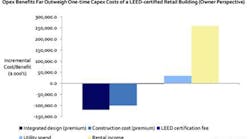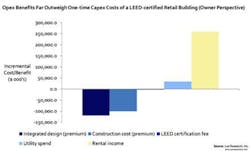In 2013, construction of green buildings rose to 325 million sq m of new floor space, with growth driven by economic benefits, rather than environmental ones, Lux Research says in a new report.
“Green buildings are driven not by utility savings, but by upticks in rental income or resale value,” Alex Herceg, Lux Research analyst and lead author of the report, “Cash Is King: Assessing the Financial Performance of Green Buildings,” said. “Those factors, along with government incentives, can make the financial case for green buildings, delivering predictable internal rates of return (IRR) north of 5 percent.”
According to Lux Research, growth has exceeded expectations, as, “Green construction marches toward a significant share of the mainstream market.” In the United States, green buildings constitute an estimated 20 percent of new construction, representing a $260 billion market.
Lux Research analysts studied utility savings, rental rates, resale value, and government incentives and their impact on green-building IRR. Among their findings:
- Green certification fuels growth. Lux Research found buildings with LEED Gold certification outperform their baseline peers. For instance, higher rental income added $4.1 million in value to a model 80,000-sq-ft commercial building in Los Angeles.
- IRR get a boost from subsidies. Incentives can lead to an IRR of 5 percent to 6 percent over 15 years.
- Energy-efficiency codes offer market opportunity. While programs such as LEED helped build market demand for green buildings, building energy-efficiency codes, such as ANSI/ASHRAE/IES Standard 90.1, Energy Standard for Buildings Except Low-Rise Residential Buildings, and the International Energy Conservation Code, can create a much larger market opportunity. In Germany, Lux Research estimates new floor space compliant with EnEV 2009 was 50 million sq m, or about 36 percent of overall new construction, in 2013.
For more on the report, go to http://bit.ly/Lux_Cash.










